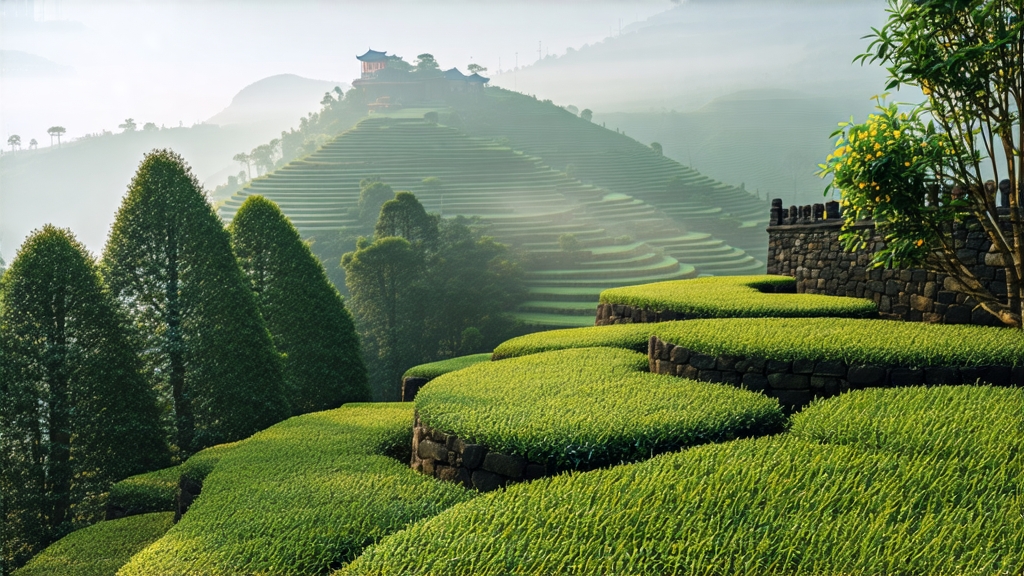
Tucked high above the Sichuan basin, where perpetual cloud veils the Min River gorge, lies Meng Ding Mountain, the cradle of the world’s oldest cultivated tea garden. Here, at roughly 1,450 m, the air is cool, the humidity constant, and the soil a loose, mineral-rich loam. These conditions conspire to slow the growth of the tea bush, concentrating amino acids and coaxing a subtle, orchid-like fragrance from the youngest leaf buds. Out of this landscape emerges Meng Ding Huang Ya—Meng Ding Yellow Bud—once pressed into imperial tribute cakes during the Tang dynasty and now the most elegant, yet least exported, of China’s six tea families.
Historical whispers
The first verifiable record appears in 808 CE, when the monk Wu Lizhen planted seven tea bushes on the summit, declaring them “celestial herbs.” By the Song dynasty (960-1279) the tea was steamed, pounded, and cast into dragon-phoenix cakes that traveled north along the Silk Road. When the Ming court abolished compressed tea in 1391, leaf-style Meng Ding Huang Ya survived because its micro-fermentation resisted the souring that plagued greener Sichuan teas on the month-long journey to Beijing. Qing emperors ranked it among the “nine indispensable tributes,” reserving the first spring picking for the imperial ancestral temple. After 1949 the garden was collectivized, then neglected; only in 2005 did a handful of families revive the original cultivar—Fuding Da Bai Hao grafted onto local Shan Cha rootstock—restoring both genetic identity and craft.
Micro-category within yellow tea
Chinese taxonomy places Meng Ding Huang Ya in the “yellow bud” sub-group, distinct from the larger-leaf “yellow small” and “yellow large” styles of Hunan and Anhui. Bud designation means the pluck is strictly one bud or one bud plus an unopened leaf, guaranteeing a high tippy appearance and a catechins-to-theaflavin ratio that softens astringency. Because the leaf is so tender, the “sealed yellowing” step can be accomplished in only 30–40 hours, half the time needed for bulkier Hunan teas, yielding a liquor that is pale champagne rather than deep amber.
Craft: the art of controlled suffocation
Harvest begins in the third week of March, when dawn mist lingers until 10 a.m. and the bud’s moisture content hovers around 78 %. Pickers wear bamboo hats but no gloves; skin contact is believed to transmit human qi to the leaf. The sacks are carried downhill within 90 minutes to a low-ceilinged workshop whose walls are blackened by decades of charcoal vapors.
- Sha Qing (kill-green): 160 °C for 3.5 minutes in a shallow, duck-egg-green wok. The goal is 65 % moisture reduction, but enzymes must remain alive for later yellowing.
- Re nao (“hot rubbing”): the leaves are rolled under muslin while still 55 °C, bruising epidermal cells just enough to release aromatic precursors without rupturing the cuticle.
- Men Huang (“sealed yellowing”): the critical signature. Buds are piled 8 cm deep in oak boxes lined with wet linen, then slid into a 32 °C, 85 % RH chamber. Every 90 minutes the pile is flipped to redistribute heat; overnight the leaf edges turn ochre as chlorophyll degrades into pheophytin.
- Low-temperature baking: charcoal embers are blanketed with 7 cm of plant ash to hold 45 °C for two hours, driving residual moisture to 7 % while locking in the nascent yellow pigments.
- Resting and selection: the tea sleeps in unglazed clay jars for 18 days, allowing Maillard notes to meld; afterward, 30 % of buds are discarded for color inconsistency, ensuring every gram that reaches market is the same honeyed straw.
Brewing: precision without pretense
Western scales often under-represent yellow tea because it tolerates neither green-tea bitterness nor black-tea heaviness. The key is thickness of liquor, not darkness.
Water: spring or filtered, 85 °C at first infusion, dropping 2 °C each subsequent pour.
Leaf ratio: 3 g per 100 ml, or one level tablespoon per 4 oz.
Vessel: a tall, thin-walled porcelain gaiwan (120 ml) or Duanni clay teapot fired at 1,050 °C—porous enough to breathe yet